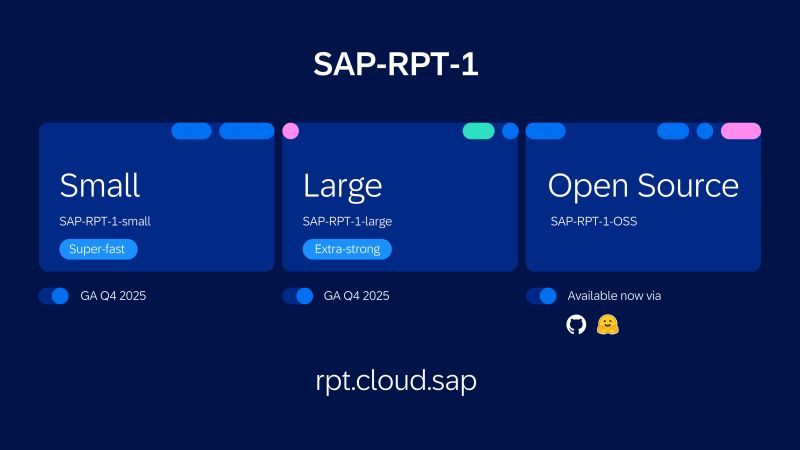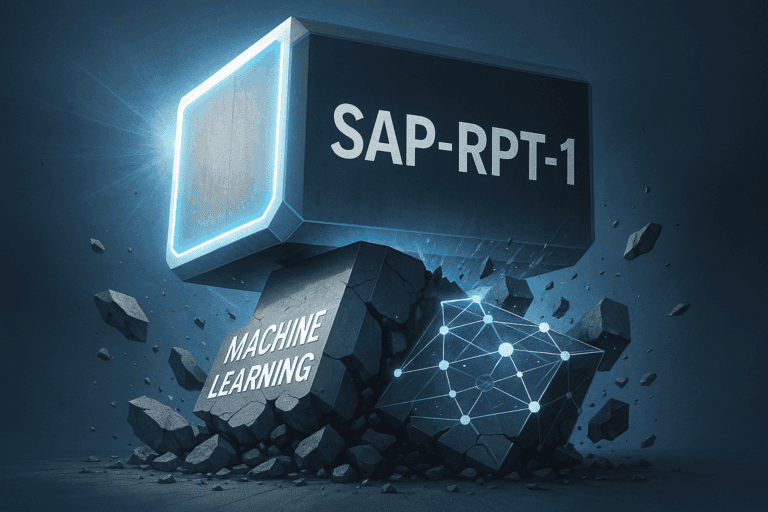At TechEd 2025, SAP is introducing its first enterprise relational foundation model, SAP-RPT-1. The model is designed to make traditional machine learning redundant by making predictions on business data without first having to train it. It will be available through SAP’s AI Foundation and as an open model on Hugging Face.
Where most AI companies build large language models (LLMs) that generate text, SAP is taking a different approach. The company is launching SAP-RPT-1, an AI model that analyzes figures and can make predictions based on them. Think of simple questions such as: Will the delivery be late? Is there a payment risk with this customer? What is the chance that this sales order will be completed?
The problem SAP is trying to solve
The interesting thing about this foundation model is that you don’t have to spend weeks training it first. You give SAP-RPT-1 the available data and a few examples, and it immediately predicts new cases. The problem with traditional machine learning is that you first have to train a machine learning model. You need a lot of high-quality, pre-screened data, you have to train and test a model, and you need machine learning experts to do that.
RPT-1 (Relational Pre-trained Transformer), on the other hand, is a generic relational model. It is pre-trained on tabular data and can make predictions immediately. No training, no fine-tuning, and no machine learning experts are needed. You give it examples, and the model immediately predicts new cases.
This is called in-context learning. Instead of spending weeks training a model, RPT-1 works immediately. SAP claims that this makes traditional machine learning projects largely unnecessary for standard business predictions.
What can you predict with SAP-RPT-1?
The model can make three types of predictions:
Yes/no decisions: Will this customer pay? Will this order arrive on time? Will this deal be closed? The model gives a yes or no answer based on historical data.
Making the right choice: Which product will this customer buy? Which department should this support ticket go to? Which supplier is the most reliable? The model chooses from multiple options.
Predicting numbers: How many days will this order be delayed? What will this customer’s turnover be? How much stock do we need? The model provides a numerical prediction.
You don’t need to train the model for all these predictions. You give it examples, or data from what happened in the past, and it predicts what will happen next.
Free playground and open-weight model
In addition to SAP-RPT-1, SAP is also launching a free web-based playground where users can test the model. The SAP-RPT Playground accepts CSV files with up to 2,073 rows and 50 columns.
Perhaps most interestingly, the model is open source. Manoj Swaminathan confirmed this to Techzine. SAP has already made the model available as an open-weight model on Hugging Face. The code is also available as open source via GitHub. Developers can therefore run the model locally and customize it to their liking.

How does it work?
The model accepts input in the form of a pandas DataFrame or a NumPy array. No preprocessing is required. Column names and cell values are automatically embedded with an LLM running in the background. Missing values are then handled correctly.
For best performance, you will need a GPU with at least 80 GB of memory. The context size can be set to 8192 for optimal results.
The underlying technology is not new. The model was previously known as ConTextTab and is described in the scientific paper “ConTextTab: A Semantics-Aware Tabular In-Context Learner.” SAP has now rebranded it as SAP-RPT-1 and made it commercially available.
Will this replace traditional machine learning?
The big question is whether SAP-RPT-1 can really replace machine learning. SAP positions RPT-1 as an alternative to traditional machine learning projects without explicitly mentioning it. It would be a pretty bold statement, but it is making an attempt to replace machine learning.
The advantages are clear: no training time, no expertise required, and it works immediately. For standard business predictions, SAP-RPT-1 could indeed make traditional ML redundant.
But it probably won’t work in all cases. The model works with in-context learning, which means you provide examples. How well does that work for complex business scenarios? And what if you want predictions that are very specific to your organization?
SAP claims that RPT-1 is suitable for “common business scenarios.” That suggests that it works for standard predictions, but perhaps not for very specific use cases. For those cases, you will probably still need to train a customized model.
SAP-RPT-1 is an important step forward in AI
Most attention in AI goes to large language models. ChatGPT, GPT-4, Claude, and Gemini, but they are all focused on generating text. However, for many business use cases, that is not always what you need. You want to make predictions based on structured data. That is what SAP-RPT-1 offers.
Traditionally, you do this with machine learning. That process takes weeks to months and requires specialized data scientists. With RPT-1, SAP is taking a different approach: a pre-trained model that works immediately without training. If this really works for standard business scenarios, it will make machine learning accessible to many more organizations. You no longer need to have an in-house data science team for simple predictions.
How well it works will become clear in the coming months. SAP will continue to develop this, so it will undoubtedly improve in the future. In any case, the most important added value is that it represents a fundamentally different approach to LLMs than the rest of the industry.
It also fits with the broader story SAP is telling at TechEd this week: more openness towards developers.
Availability
SAP-RPT-1 will be generally available in Q4 2025 on the generative AI hub in SAP’s AI Foundation. The open-weight model on Hugging Face is already available. SAP announces that more models from the SAP-RPT family will follow.
